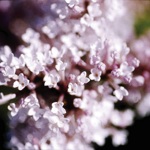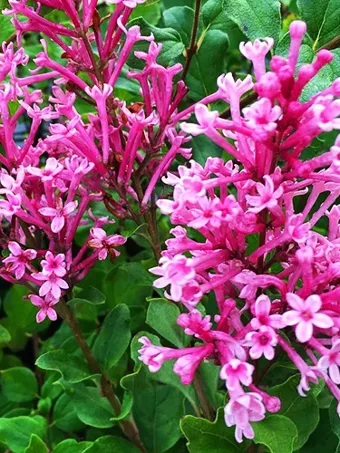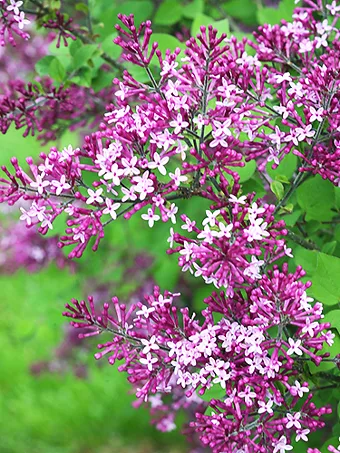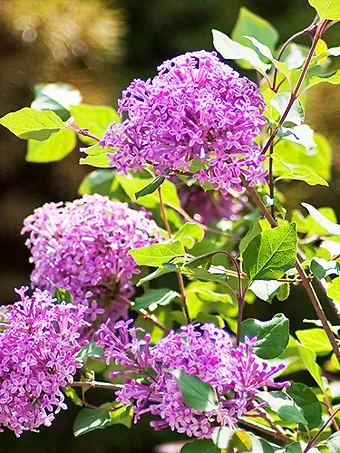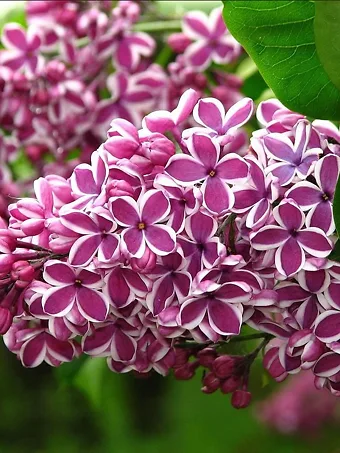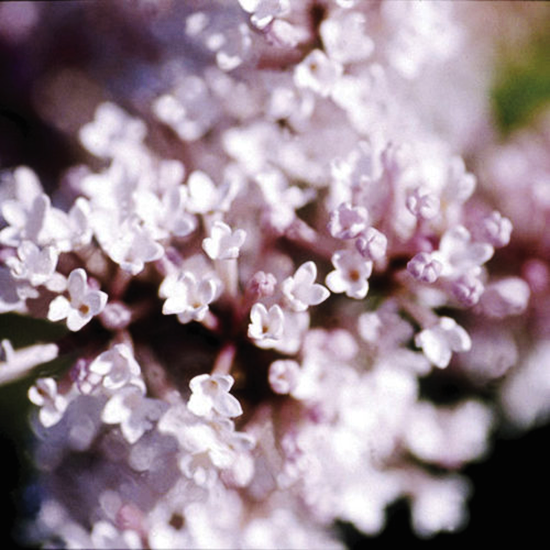
Thumbelina Lilac
Syringa hybrid 'Bailina' (PP# 16,662)View more from Lilacs
Thumbelina Lilac
Syringa hybrid 'Bailina' (PP# 16,662)
30 day - ARRIVE AND THRIVE™ guaranteeLearn more


Special Features

Botanical Name
Syringa hybrid 'Bailina' (PP# 16,662)
Outdoor Growing zone
3-7
Mature Height
5-6
Mature Width
4-6
Sun needs
Full Sun
The Thumbelina® Lilac brings the wonderful brightness of pink to your spring blooms. This compact plant grows just 6 feet tall and wide, making it ideal for smaller spaces, where full-size lilacs won’t fit. In May it is smothered in bunches of blossoms, dark-pink in bud, opening to light pink, and gradually becoming almost white. The blooms have an exceptional fragrance, and nothing beats the smell of lilacs. Grow this plant around your home, beside a window or door, or in beds out in the garden. Make an informal hedge with it, or plant it for screening. After blooming its neat foliage always looks good.
- Densely covered in trusses of pink blooms
- Very highly fragrant, filling the air around it
- Blooms all through the second half of May
- Very winter-hardy, even in zone 3
- Needs no trimming or dead-heading
The Thumbelina® Lilac is very cold-resistant, growing well in zone 3, and blooming profusely, as well as growing in all zones except for 8 and 9. It thrives in ordinary garden soils and conditions, and it should be planted in full sun for maximum blooming. No special care is needed, and dead-heading and pruning are unnecessary. If you do need to trim, do it only immediately after flowering has finished. Pests and diseases are usually no problem, and this plant is very easy to grow.

Medium-sized shrubs are essential components in the garden, filling in middle areas in larger gardens, and making background in smaller ones. Around the house they fill corners and the spaces between windows and beside doors, without growing too large and blocking the light. In colder parts of the country gardeners rely on deciduous shrubs, and classic plants like lilacs are incredibly useful garden plants you can’t be without. Not only are they valuable for their bulk and form, but their gorgeous flowers, with that incomparable perfume, are essential for late spring, filling your garden with color and scent. That is what Neal Holland, from North Dakota, thought too, when he developed his Fairy Tale® series of dwarf lilacs. They needed to be small enough to fit into any garden, so he bred them to be just 5 or 6 feet tall; they needed to be very hardy to survive the rigorous winters of northern states; and they needed to be easy to grow. He succeeded in all those goals, and one of the most beautiful of his ‘children’ is the Thumbelina® Lilac, whose light pink blooms are the most fragrant of the series and bring back the wonder of childhood to us all.
The Thumbelina Lilac might be delicate in bloom, but it is tough in the ground, and this hybrid plant grows into a dense, twiggy, rounded shrub no more than 5 or 6 feet tall, and the same size across. It keeps its branches right to the ground, and it needs no trimming to stay compact and neat. Compare that to traditional lilac bushes, which usually grow at least twice that size and need regular pruning at just the right times of year, while the Thumbelina Lilac needs nothing at all. The rounded leaves are perfectly in scale, just a little more than one inch long, and a rich, dark green. After flowering this neat plant looks perfect as a background, filling spaces and showing off your later blooming plants.
The flowers of the Thumbelina Lilac are born in profusion all over the bush, at the ends of every branch. Flowering begins around the middle of May, a little later in very cold zones, a little earlier in warmer ones. The flowers are carried in long, fat bunches, and each large bunch is over 3 inches long, with about 150 blossoms in it. In bud the flowers are dark pink, and they open first at the bottom of each cluster, showing a delightful lighter pink. Each individual bloom lasts a week, gradually fading to almost white, and it takes 3 or 4 weeks for blooming to be completely over. The changing color tones within each flower bunch, and over the bush as a whole, makes for a delightful, ever-changing display. If you enjoy pink, you will love the many pinks this lilac gives us. All the time the flowers are open they give off a strong, spicy, classic lilac scent, filling the air around it.
Grow the Thumbelina Lilac as a single plant in a smaller bed, or in groups in larger ones. Its broad size means that just a few will fill large spaces, and always look great. Grow it as the background to smaller beds or use it between lower shrubs and small trees in a bigger one. Plant a specimen on a lawn, beside a path, or near a door, to enjoy its color and scent close-up. This shrub also makes a wonderful informal hedge or lower screen, needing no trimming and always looking neat and full.
The Thumbelina Lilac is hardy in all the coldest zones, from zone 3 to zone 7. It is invaluable for gardens in colder states, and it flowers reliably no matter how harsh the winter. Plant it in full sun for full blooming. It will grow in any garden soil, except for wet ones, and don’t plant where water and ice build up on the soil in winter. It needs no special care, although a little shrub fertilizer in spring will help it along. If your soil tends to be dry and sandy, adding some organic material, and using it as a mulch, will be beneficial too. Once this bush is established it is drought resistant in cooler zones. It normally has no important pests or diseases, and unlike older types of lilac it makes no seeds, so it doesn’t even need dead-heading – the old flowers quickly fade away. If you do need to trim your bush, do it only immediately after flowering, as trimming at other times will reduce or even eliminate flowering.
This great lilac was created by Neal Holland, a horticulture teacher at North Dakota State University, and owner of Sheyenne Gardens nursery, in Harwood, North Dakota. In 1976 he decided to breed a new, compact lilac, with good winter hardiness and large, fragrant flowers. He crossed together a form of the Korean lilac, Syringa meyeri `Palibin`, with the Little-leaf Lilac, Syringa pubescens subsp. microphylla ‘Superba`. He then grew the many seedlings, and in 1985 he selected the very best four plants to be his Fairy Tale® Lilacs. The other varieties are Prince Charming, Tinkerbelle, and Sugar Plum Fairy. The most delicious soft pink he named Thumbelina®, and you will love her in your garden. Officially called ‘Bailina’, Holland was granted a patent on his new plant in 2006. He joined with Bailey Nurseries of St Paul, Minnesota, to make these great plants available, and you will simply love them. However, our stock is limited, and our northern clients really want these plants for their gardens, so order now, while we still have plants available.
